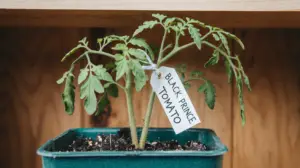Urban farming is getting more popular in cities. People want to know where their food comes from. Even a blank terrace can become a garden with the right planning.
Rooftop gardens are becoming more common. This is because cities have less space and people want to be greener. It’s a healthy way to grow food and use unused space.
Whether you have a small balcony or a big rooftop, you can make your own garden. Start growing vegetables on your terrace. This guide will help you make your terrace a garden. You’ll get fresh, tasty produce right at your door.
Table of Contents
Benefits of Urban Terrace Gardening
Turning your urban terrace into a garden brings many benefits. It’s not just about looks. You can create a space for organic food and eco-friendly habits in the city.
Temperature Control and Energy Savings
Terrace gardens help control your home’s temperature. They can lower your house’s temperature by up to 7%. This means big savings on cooling costs all year.
Sustainable Food Production
Growing your own food on your terrace is empowering. It cuts down on store-bought produce and its carbon footprint. Plus, composting food waste helps the environment and your soil.
Pesticide-Free Fresh Produce
With a terrace garden, you can have fresh, pesticide-free food anytime. It’s healthier and tastes better. A small garden can feed a family of four all season.
Urban terrace gardening does more than just benefit you. It helps the whole community become greener and more sustainable. By gardening this way, you’re making a difference in your city.
Essential Tools and Materials for Your Terrace Garden
To create a thriving container gardening space on your terrace, you need the right tools and materials. For small gardens, a basic set of hand tools is enough. This includes a trowel, hand fork, cultivator, watering can, and bypass pruners.
But for larger terrace gardens, you might need more tools. You might need a shovel, rake, hoe, and a garden cart or wheelbarrow. These tools help with bigger tasks.
For those who love gardening, there are optional tools to make the job easier. A garden tiller, waterproof boots or clogs, a garden fork, and a garden cart or wheelbarrow are great additions. Also, consider irrigation equipment like soaker hoses, drip irrigation tubing, and emitters for efficient watering.
Many gardening enthusiasts find outdoor potting tables essential for organizing your workspace. You’ll also need stakes, trellises, and garden string to support your plants. It’s wise to stock up on organic fertilizers, soil amendments, grow bags, and mulch before planting season starts.
Lastly, don’t forget protective equipment. Gloves, hats, and knee protection are key for your safety and comfort while gardening.
| Terrace Gardening Essentials |
|---|
| Trowel, Hand Fork, Cultivator |
| Watering Can, Bypass Pruners |
| Shovel, Rake, Hoe, Garden Cart/Wheelbarrow |
| Garden Tiller, Waterproof Boots/Clogs, Garden Fork |
| Soaker Hoses, Drip Irrigation Tubing, Emitters |
| Outdoor Potting Table |
| Stakes, Trellises, Garden String |
| Organic Fertilizers, Soil Amendments, Grow Bags, Mulch |
| Gloves, Hats, Knee Protection |
This list is not exhaustive. The tools and materials you need will depend on your garden’s size and complexity. The most important thing is to have the right equipment for a successful gardening journey.
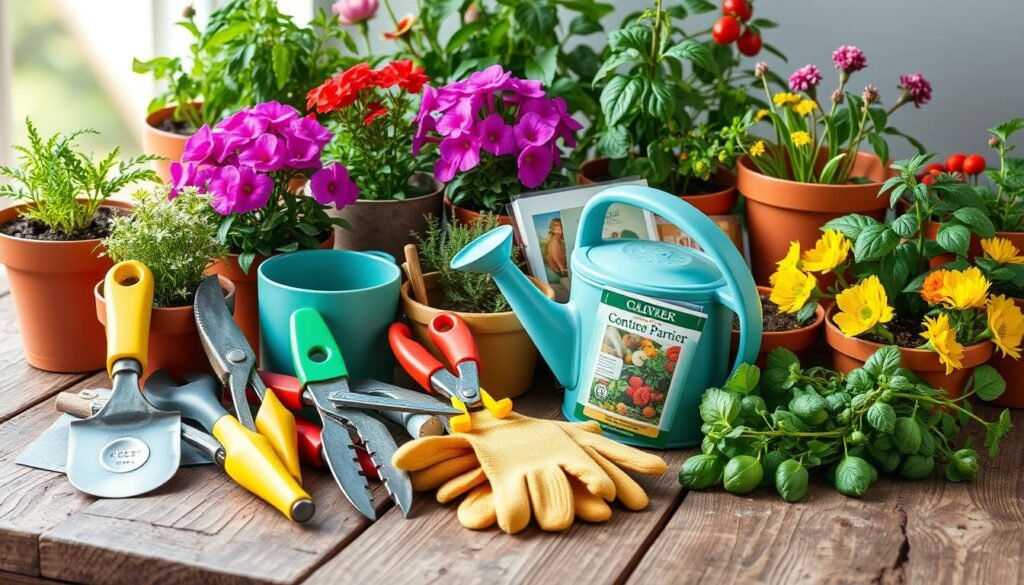
How to Grow Vegetables on Terrace: Getting Started
Turning your terrace into a garden is exciting. It lets you grow fresh, pesticide-free food. Whether you’re new to gardening or experienced, planning is key. Choose the right containers and methods for a thriving garden.
Preparing Your Terrace Space
First, check your terrace’s conditions. Look at sunlight, wind, and water sources. A sunny spot, like the south or west, is best for plants. Also, watch for shading from buildings.
Waterproofing and Drainage Solutions
Waterproofing and drainage are vital. Use a 6-stage curing process for the surface. Raised beds or planters help with drainage and prevent soil damage. This keeps your home safe and your plants healthy.
Choosing the Right Containers
Container size is important. Choose big pots, like 100-liter drums, for better root space. Leafy greens and herbs need at least 10 inches, while carrots and potatoes need up to 24 inches. Use stands or casters for better airflow and drainage.
With proper preparation, waterproofing, and container selection, your garden will thrive. Follow these steps for a successful rooftop or balcony garden. You’ll enjoy fresh, tasty vegetables right outside your door.
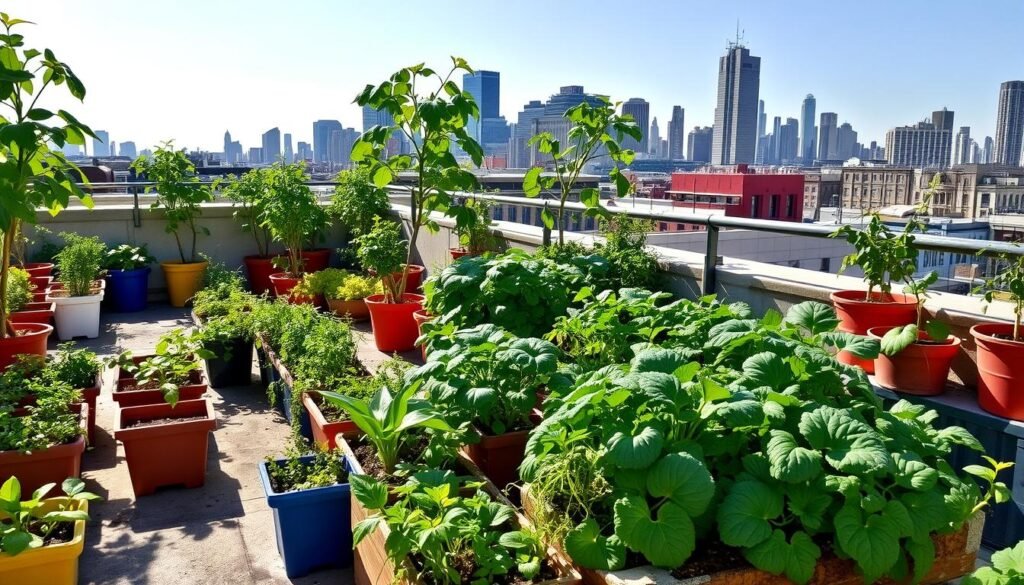
Perfect Soil Mix for Container Growing
When growing vegetables on your terrace, the key to success lies in the soil mix you choose. The ideal soil should be lightweight, nutrient-rich, and well-draining. This ensures your plants thrive in the confined container space. To create the perfect potting mix, blend garden soil, coco-peat, organic fertilizers, vermicompost, and perlite.
Balancing the soil’s pH is very important. This is true if you’re using acidic components like peat moss or compost. Adding garden lime can help prevent issues like blossom end rot in tomatoes. It keeps the pH in the optimal range. For a complete nutrient profile, use a mix of slow-release organic fertilizers (like Kellogg’s) and quick-release non-organic fertilizers (like Miracle-Gro).
| Soil Component | Preferred pH Range | Nutrient Needs |
|---|---|---|
| Tomatoes | 6.0-6.8 | High Nitrogen |
| Blueberries | 4.5-5.5 | Acidic |
| Beets and Asparagus | 6.0-8.0 | Slightly Alkaline |
For long-term container plants, mix loam soil and compost. The Glomus intraradices fungus is good for most herbaceous plants. It promotes healthy root systems. Remember, the smaller the soil volume, the more critical the substrate properties become. So, choose the right mix for your specific terrace garden needs.
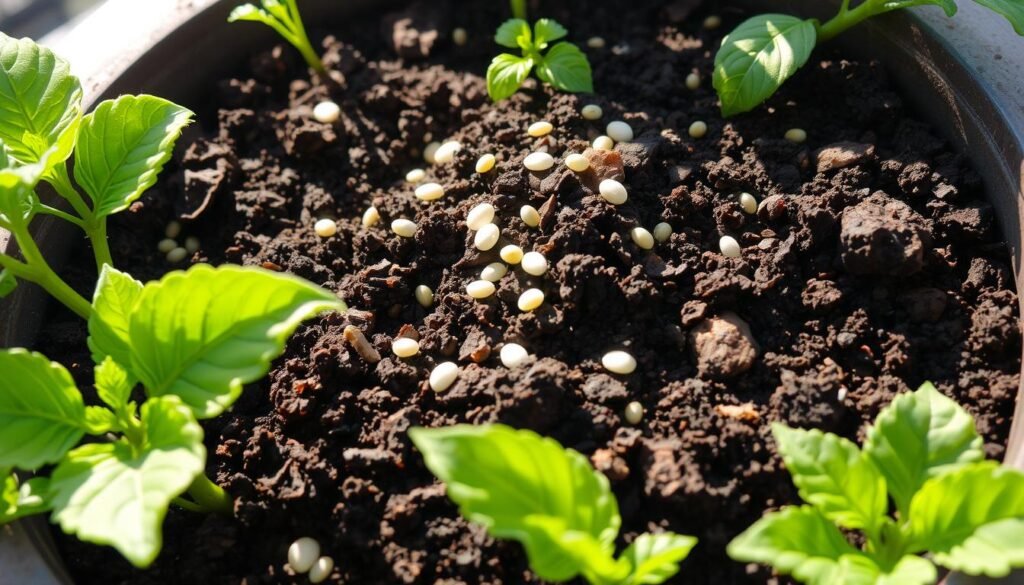
“The larger the container for growing vegetables, the less frequent the need for watering and fertilizing.”
Best Vegetables for Terrace Gardens
Starting an urban terrace garden is exciting. You can grow many urban vegetable varieties and terrace-friendly crops. These can thrive in small spaces like balconies or rooftops.
Leafy Greens and Herbs
- Swiss chard: Vibrant leaves with a mild, slightly sweet flavor.
- Kale: Nutrient-dense leaves that are perfect for salads and smoothies.
- Arugula: Peppery leaves add a zesty kick to any dish.
- Lettuce: Grow different varieties for a continuous supply of fresh greens.
- Mustard greens: Tender leaves with a slightly spicy taste.
- Spinach: A versatile leafy green that can be enjoyed raw or cooked.
- Herbs: Grow a selection of herbs like dill, cilantro, parsley, and mint for fresh flavors.
Root Vegetables
- Radishes: Quick-growing and perfect for small spaces.
- Beets: Vibrant roots with a sweet, earthy flavor.
- Sweet potatoes: Produce a bountiful harvest in a compact space.
- Turmeric: An exotic root with numerous health benefits.
- Ginger: Grow this flavorful rhizome in a large container.
Fruiting Plants
Don’t just stop at leafy greens and roots. Add some fruiting plants to your garden. Here are a few:
- Tomatoes: Cherry, plum, or beefsteak varieties thrive in containers.
- Cucumbers: Trailing vines can be trained to climb trellises or cages.
- Beans: Bush or pole varieties add protein-rich veggies to your harvest.
- Eggplants: Compact, bushy plants produce delicious fruits.
- Peppers: From sweet bells to spicy chili peppers, these plants do well in pots.
For a unique touch, try growing dwarf fruit trees like sapota, guava, citrus, and bananas. They need large containers. Pick plants with short growth cycles for a steady harvest from your urban garden.
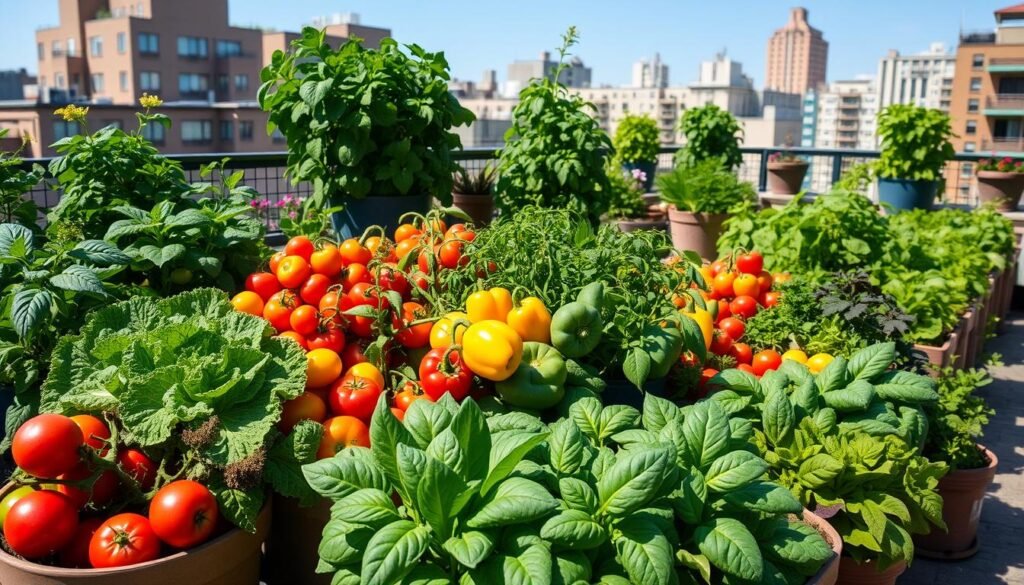
Smart Watering Systems and Irrigation
Creating a vibrant terrace garden needs a good watering system. The Garden Grid™ smart watering system is a smart choice. It uses drip irrigation to water plants at their roots. This method cuts down on fungal diseases and helps roots grow strong.
Adding a timer makes watering easier. You can set it to water in the morning and again in the afternoon during hot days. This way, your garden stays lush and green, no matter the weather.
| Feature | Benefit |
|---|---|
| Drip-irrigation system | Reduces risk of fungal diseases, promotes better root development, and ensures even water distribution |
| Customizable watering timer | Allows for automated watering based on weather conditions and plant needs |
| Versatile design | Accommodates various garden bed sizes and shapes, including raised beds and hot climates |
Using a smart watering system makes gardening easy. You save water and help plants grow well. No more manual watering needed. Enjoy a lush, productive, and green outdoor space.
Natural Pest Control and Plant Protection
Keeping your organic terrace garden healthy is more than just growing the right plants. It also means using organic pest control methods to protect your crops. Try using chili and garlic decoctions, neem oil mixed with common detergent, and marigold petals. These natural pesticides can keep pests away without harming your plants or the environment.
Organic Pest Management
Checking your plants regularly is key to catching pests or diseases early. This quick action helps stop problems before they get worse. Diatomaceous earth fights crawling insects like ants and beetles. Neem oil helps with aphids, mites, whiteflies, and some fungal diseases.
Companion Planting Strategies
Companion planting is a traditional method for managing pests and attracting pollinators. Mix aromatic herbs like basil, tulsi, and fennel with your vegetables. They not only taste great but also keep pests away, making your garden a healthy, thriving space.
“Proper spacing between plants allows for good air circulation, which can help prevent the buildup of moisture, creating a favorable environment for pests and diseases.”
Using organic pest control and companion planting can make your terrace garden a success. It will be pesticide-free, full of harvests, and help make your city a greener place.
Vertical Growing Solutions for Space Optimization
Maximizing your terrace space is key, and vertical gardening is the perfect answer. It lets you grow a lush garden even in tight spots. Hang planters on walls and train vines like beans and tomatoes to grow up and out.
This method not only saves space but also looks amazing. It turns your terrace into a stunning and fruitful display.
Vertical gardening is great for small terraces, letting you grow more in less space. Stackable planters are perfect for saving resources like soil and water. Hanging containers make it easy to check on your plants and keep them healthy.
Trellises, fences, and walls are great for supporting climbing plants. Vining plants like beans and cucumbers look beautiful trailing down these supports. Leafy greens and herbs like mint and parsley also do well in vertical gardens.
Adding trailing plants brings a touch of beauty to your vertical garden. Hanging baskets and living walls are also great for saving space. They let you grow many plants without cluttering your terrace.
Vertical gardening is not just about saving space; it’s also eco-friendly. You can use old pallets and containers to make trellises and arbors. This way, you can create a lush, efficient urban garden on your terrace.
Seasonal Planning and Maintenance Tips
Successful gardening on your terrace needs careful planning and regular upkeep. To grow a thriving urban vegetable garden, match your planting with the seasons and local weather. Use gardenate.com to find the best times to plant different veggies in your area.
Regular pruning and harvesting are key to keeping your garden healthy. For example, cutting back Nasturtium flowers can make them bloom all year. Also, using crop rotation helps keep the soil healthy and stops pests from building up.
Spending just half an hour a day on your garden can make a big difference. This includes watering, weeding, and checking for pests or diseases. With some seasonal planning and garden maintenance, you can enjoy fresh, homegrown vegetables from your urban garden.
“Maintaining a thriving terrace garden requires a commitment to seasonal planning and regular maintenance, but the rewards are well worth the effort.”
Conclusion
Terrace gardening brings many benefits, like fresh, pesticide-free food and a greener city. Even small spaces can become gardens with the right planning and care. Urban farming is not just a hobby but a way to grow your own food sustainably. It connects city folks with nature, leading to a healthier lifestyle and a greener future.
Adding terrace gardening to your urban life has many perks. It can lower blood pressure, reduce anxiety, and improve air quality. It also attracts good insects. The trick is to pick the right plants, keep the soil healthy, and manage water and pests well.
As more people choose sustainable living, urban farming and terrace gardening will grow. By growing your own food, you help make a difference. You’ll also enjoy the many benefits that come with it.


